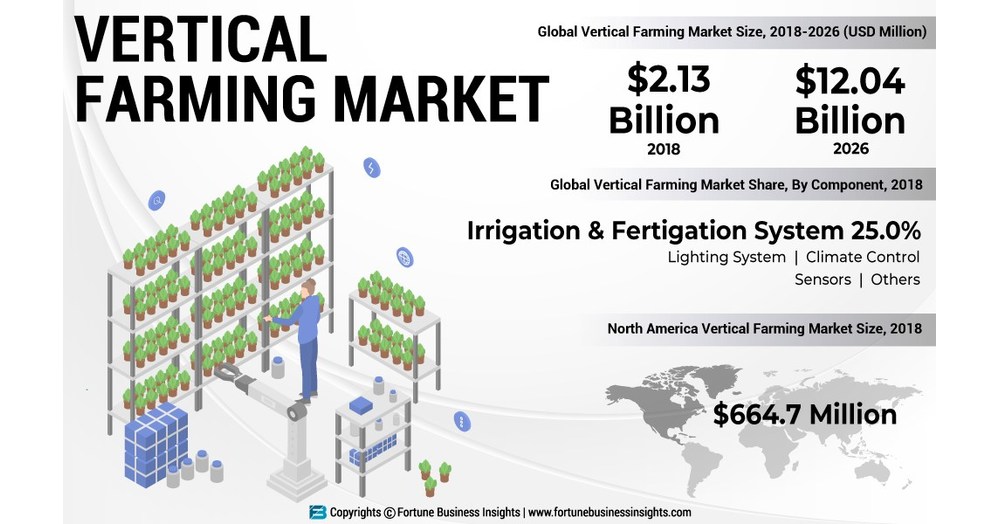Indoor Vertical Farming Market Overview and Growth Trends

Vertical Farming Market to Rise at 24.8% CAGR Till 2026; Growing Demand
The Vertical Farming Market is projected to grow at a CAGR of 24.8% until 2026, owing to the increasing demand for food production and the growing popularity of indoor farming techniques. Vertical farming is a method of producing crops in vertical layers, using artificial lighting and climate control, without the need for soil or natural sunlight. This technology is highly efficient as it provides optimal growing conditions and allows crops to mature much faster than in traditional farming methods.
Abstract
Vertical farming has emerged as a highly efficient and sustainable method for producing crops. With the growing demand for food and increasing concerns about the environmental impact of traditional agriculture, vertical farming has become a popular alternative. This report analyzes the global vertical farming market, including key players, market size, and growth prospects. The report also highlights the various benefits of vertical farming and the challenges faced by the industry. The analysis indicates that the vertical farming market is poised for significant growth in the coming years.
Introduction
Vertical farming is a cutting-edge technology that uses artificial lighting and precise climate control to create optimal growing conditions for crops. This technology allows crops to be grown in vertical layers, without the need for soil or natural sunlight. Vertical farming is highly efficient as it saves space, water, and other resources, and produces higher yields than traditional agriculture. Additionally, vertical farming is less impacted by climate change and offers a more reliable and sustainable way to produce crops.
The global vertical farming market is projected to grow at a CAGR of 24.8% until 2026, according to a recent report. The major factors driving this growth include the increasing demand for food production, rising adoption of indoor farming techniques, and the need for sustainable agriculture. The report also highlights the key players in the vertical farming market, including Aerofarms, Bright Farms, Plenty Inc, and others. These companies are investing in research and development to improve the efficiency and sustainability of their vertical farming operations.
Content
Benefits of Vertical Farming
Vertical farming offers several benefits over traditional agriculture. One of the main advantages is the ability to produce crops in any location, regardless of climate or weather conditions. This means that crops can be grown year-round, regardless of the season. Additionally, vertical farming uses 70-90% less water than traditional agriculture, making it a highly sustainable method of crop production.
Another benefit of vertical farming is that it requires less space than traditional agriculture. This is because crops are grown in vertical layers rather than horizontally, which saves space. As a result, vertical farming is an ideal solution for urban areas where space is limited.
Vertical farming also offers higher yields than traditional agriculture. This is because crops can be grown closer together, and vertical farming uses highly efficient LED lighting systems. As a result, crops can be grown faster, and yields are higher than in traditional farming methods.
Challenges Faced by the Industry
Despite the benefits of vertical farming, the industry faces several challenges. One of the main challenges is the high initial cost of setting up a vertical farm. This is due to the high cost of equipment, such as LED lighting systems, climate control systems, and hydroponic systems.
Another challenge is the high energy consumption of vertical farms. The artificial lighting and climate control systems used in vertical farming require a significant amount of energy, which can be costly and may contribute to climate change.
Additionally, vertical farming requires a high level of technical expertise. Farmers must be highly skilled in crop production, hydroponics, and technology to ensure efficient and sustainable crop growth. This can be a challenge for some farmers who may not have the necessary skills or training.
Market Size and Growth Prospects
The global vertical farming market is expected to grow at a CAGR of 24.8% until 2026, according to a recent report. The market is driven by the increasing demand for food production, rising adoption of indoor farming techniques, and the need for sustainable agriculture. The Asia-Pacific region is expected to be the fastest-growing market for vertical farming, owing to the increasing population and rising demand for food.
The report also highlights the key players in the vertical farming market, including Aerofarms, Bright Farms, Plenty Inc, and others. These companies are investing in research and development to improve the efficiency and sustainability of their vertical farming operations. For instance, Aerofarms has developed a patented technology that uses aeroponics to grow crops without soil, resulting in higher yields and more efficient use of resources.
Other companies, such as Bright Farms and Plenty Inc, are using vertical farming to produce fresh, locally grown produce for consumers. These companies are building vertical farms closer to urban areas to reduce transportation costs and provide consumers with fresher produce.
Conclusion
Vertical farming is a highly efficient and sustainable method for producing crops. The technology allows crops to be grown in any location, regardless of climate or weather conditions, and saves space, water, and other resources. The global vertical farming market is projected to grow at a CAGR of 24.8% until 2026, driven by the increasing demand for food, rising adoption of indoor farming techniques, and the need for sustainable agriculture. While the industry faces several challenges, such as high initial costs and high energy consumption, key players in the market are investing in research and development to improve the efficiency and sustainability of their operations.

Source image : www.openpr.com

Source image : www.prnewswire.com
/cdn.vox-cdn.com/uploads/chorus_asset/file/11636867/verticalfarming4farmone.jpg)
Source image : www.eater.com




